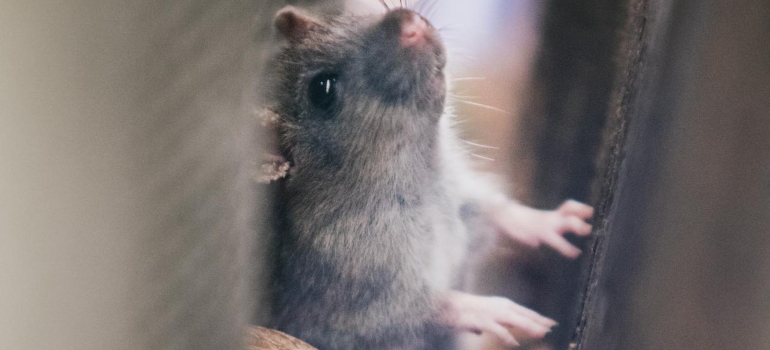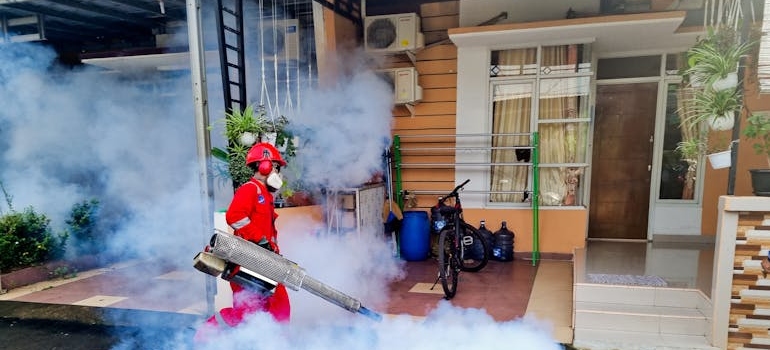How to Pest-proof Your Seattle Home After Moving
Stepping into your new Seattle home marks the beginning of a thrilling experience, but it’s important to be aware of a hidden challenge: the city’s wet climate is perfect for pests. From ants and spiders to mice, these pests can quickly become a big problem, damaging your home and affecting your health. It’s vital to take steps to pest-proof your Seattle home as soon as you move in. If you don’t, these pests can cause expensive damage and become harder to get rid of over time. This Hansen Bros. Moving & Storage guide will help you understand how to protect your home right from the start. Following some straightforward strategies we have in store will ensure your new home in Seattle remains safe and welcoming, allowing you to enjoy your fresh start without the hassle of unwanted guests.
Understanding Seattle’s Common Pests
Seattle’s moist and wooded environment makes it a prime habitat for a variety of pests, including rats, mice, ants, and spiders. These creatures can be a nuisance and pose significant risks to your home and health. Understanding these common pests’ characteristics, behaviors, and potential threats is the first step in effectively keeping them at bay.
Rats and Mice
These rodents are infamous for their ability to adapt and thrive in various environments, including human homes. Rats and mice are attracted to homes primarily for shelter and food. They can squeeze through small gaps (as tiny as a quarter for rats and a dime for mice), making virtually any home vulnerable to their entry.
Once inside, they can cause considerable damage by gnawing on everything from electrical wires to structural components, potentially causing fire hazards and expensive repairs. Health-wise, rodents are carriers of diseases such as hantavirus and salmonella, which can be transmitted through their droppings, urine, or saliva.
Various Ants
Seattle is home to several ant species, including the odorous house ant, the carpenter ant, and the pavement ant. These ants have varied nesting habits—carpenter ants, for instance, burrow into wood, potentially compromising structural integrity. In contrast, odorous house ants are more likely to nest in moist areas inside homes.
Ants typically enter homes in search of food, particularly sweets and proteins, and once they establish a trail, they can be difficult to eradicate. The damage from ants ranges from contaminated food to serious property damage (in the case of carpenter ants).

Common Spiders
Several common spiders in Seattle, such as the giant house spider and the cross orb-weaver, are harmless but can be unsettling. More concerning are species like the hobo spider and the black widow, which are venomous and can pose health risks if they bite humans. Spiders generally enter homes in search of prey, which means they often follow other pests into your home. Keeping a pest proof home free of other insects can reduce the likelihood of a spider infestation.
Initial Assessment of Your New Home
Once your chosen moving company in Washington leaves your home, it’s inspection time. Before unpacking, take the time to conduct a detailed examination of your new Seattle home for any signs of pest activity. Look for droppings, which are a clear indicator of rodents or smaller pests. Check for spider webs, eggs, and nests in corners, behind furniture, and in less trafficked areas like basements and attics.
Gnaw marks on furniture, wiring, and walls can also signify a rodent problem. Inspect packages and furniture as they are brought in, as pests can hitchhike into your home this way. Utilizing a flashlight will help you spot these signs in dark, hidden areas.
Identifying Potential Entry Points for Pests
Pests can enter your home through surprisingly small openings. To pest-proof your Seattle home, start by examining its exterior. Look for cracks in the foundation, gaps around windows and doors, and holes around the roofing or in the attic. Vents and pipes that lead outside should also have secure screens to prevent entry.
Seal any gaps using appropriate materials such as caulk for small cracks, steel wool for gaps around pipes, and weather stripping for doors and windows. Ensuring these entry points are blocked is a key step in preventing pests from making your home theirs.
Importance of Checking Damp Areas, Cracks, and Crevices
Damp areas are particularly attractive to many pests, including ants, spiders, and rodents, as they provide the necessary moisture for their survival. Pay special attention to kitchens and bathrooms, especially under sinks and along pipelines, where leaks might occur.
Basements and attics should be checked for any signs of dampness or water damage, which can also attract pests. Regularly inspect these areas for new cracks or crevices and seal them promptly. Addressing dampness can involve dehumidifiers or proper ventilation, which are effective at keeping many pests at bay.

Cleaning and Maintenance to Pest-proof Your Seattle Home
Maintaining a clean and orderly home is as crucial in preventing pest infestations as knowing how to pest proof your home after moving in with moving services in Seattle. Here’s how you can implement effective cleaning and maintenance strategies to keep your home pest-free.
Deep Cleaning Tips Post-Move to Eliminate Potential Pest Attractants
After moving, it’s important to undertake a thorough deep cleaning to eliminate any factors that could attract pests. Start with vacuuming all carpets and rugs intensively, as these can harbor pest eggs and food particles. Scrub all surfaces, especially in the kitchen and bathrooms, with a strong disinfectant to remove residues that could attract ants or other insects.
Don’t forget to wash all windows and door frames to remove cobwebs and any eggs that spiders may have laid. Deep cleaning not only helps in eliminating immediate pest attractants but also gives you a clean slate to maintain a pest-free environment.
Advice on Regular Maintenance to Keep Pests at Bay
Consistency in home maintenance is key to keeping pests out. Regularly inspect and clean your home, focusing on areas that are prone to dampness and clutter, as these are attractive to pests. Seal any new cracks or openings in walls, around windows, and baseboards with caulk or another appropriate sealant.
Check for leaking pipes and clogged drains, as standing water can attract pests like cockroaches and mosquitoes. Ensure that vents are clear of debris, and consider installing mesh screens to prevent pests from entering through them.
How to Properly Store Food and Dispose of Waste to Avoid Attracting Pests
After you unpack your moving boxes in Seattle, its damp climate makes it essential to immediately establish good habits for food storage and waste disposal to prevent pest infestations. Store food in sealed containers, and never leave it out overnight. Make sure to clean food preparation areas after each use to remove grease and crumbs.
Dispose of garbage regularly in sealed receptacles. Ensure that all compost bins are away from the house and properly managed so as not to attract rodents or flies. Additionally, manage your recycling bins by rinsing out food containers before disposal to avoid attracting pests.

Seasonal Guide for Maintaining a Pest-Free Home in Seattle
To effectively prevent pests all year round, adopting a seasonal approach to home maintenance is crucial unless you’re using safe Seattle storage. Each season brings different challenges and opportunities for pest control. Here is a tailored guide to help you manage your pest-proofing efforts through the changing seasons in Seattle:
- Spring: As temperatures rise, so does pest activity. Spring is the ideal time to check for any signs of pest activity that might have begun during the cooler months. Inspect your home thoroughly for any breaches made over winter and repair them. Clear away debris and leaf litter from your yard, as these can provide nesting materials for rodents.
- Summer: This season requires vigilance against insects such as ants, flies, and mosquitoes. Ensure your window screens are intact to keep flying pests out. Keep your yard trimmed and free from standing water—typical breeding grounds for mosquitoes. Regularly inspect the foundation and roof for signs of termites and other insects.
- Fall: Prepare for colder weather by ensuring your home is sealed against rodents seeking warmth. Check for gaps around doors and windows, replace worn weather stripping, and inspect the attic and basement for entry points that need sealing.
- Winter: The cold months are less active for pests, but it’s a good time to prepare and pest-proof your Seattle home for the next year. Continue to monitor for signs of rodent or insect activity, particularly in warm areas like utility rooms. Keep your home dry and well-ventilated to prevent condensation and mold, which can attract pests.
Using these seasonal strategies will help you tackle current pest problems and prevent new ones from popping up. Staying proactive all year long will keep your Seattle home safe and pest-free, letting you enjoy each season without any worries.
Sealing and Fortifying Your Home
Creating a barrier against pests is a critical step in securing your Seattle home before your West Seattle movers bring in your belongings. This is how you can effectively seal and fortify your home against unwanted pest invaders:
- Inspect Your Home: If you wonder how to pest proof your house, begin by thoroughly inspecting its interior and exterior. Pay special attention to areas where utility pipes enter, along baseboards, around doors and windows, and any vents.
- Clean Surfaces: Before sealing, clean the areas around any openings. This ensures that the sealant adheres properly and lasts longer.
- Choose the Right Sealant: For most cracks and gaps, a silicone-based caulk works well because it’s durable and flexible. It can withstand the weather conditions typical in Seattle.
- Apply Sealant: Use a caulking gun for precise application. Fill all visible cracks and gaps, smoothing out the caulk with a damp finger or tool to ensure it seals completely.
- Check for Larger Gaps: For gaps wider than half an inch, use a foam sealant or mesh before caulking to ensure a solid barrier.
- Seal Windows and Doors: Apply weather stripping around doors and windows to prevent pests from entering through the tiny gaps.
Speaking of sealants, choosing the right materials and application techniques is crucial for creating an effective barrier against pests. Here are some recommendations for materials and techniques to use for effective sealing:
- Silicone Caulk: The solution is ideal for waterproofing and preventing moisture-driven pests.
- Expanding Foam: It is best for larger gaps, particularly in less visible areas, as it expands to fill the space.
- Steel Wool: This pest proof insulation is effective for plugging gaps where rodents might enter, as they can’t chew through it.
- Weather Stripping: Use it around doors and windows to keep insects out and improve your energy efficiency.
Sealing and fortifying your home sets up a strong defense against unwanted pests. Keep up with these steps regularly to ensure your Seattle home stays safe and comfortable.
Natural and Chemical Repellents
In the battle against pests in your Seattle home, both natural and chemical repellents can play crucial roles. Starting with natural remedies, many homeowners find that items like essential oils—peppermint, tea tree, lavender, and eucalyptus—are effective at deterring a variety of insects. Vinegar, too, can be used to pest-proof your Seattle home and create barriers at entry points to keep ants and other pests at bay. These solutions are particularly appealing for their low environmental impact and safety around children and pets.

However, there are situations where natural repellents may not suffice, and chemical repellents and pesticides become necessary. They are especially useful in dealing with larger infestations or more resilient pests such as cockroaches and bed bugs. When opting for chemical repellents, it’s crucial to choose products specifically designed for the type of pest you’re dealing with and follow the manufacturer’s instructions carefully.
Safety is paramount when using chemical solutions inside your home. Especially when learning how to pest-proof a pantry or other sensitive areas where food is stored. Always wear protective gear, such as gloves and masks, when applying pesticides. It’s also wise to test the product in a small area first. It is to check for any adverse reactions to your home surfaces.
Professional Pest Control and Prevention
Sometimes, despite your best efforts, professional pest control in Seattle, Washington, may be necessary. If you’re dealing with persistent infestations, large colonies, or difficult-to-eradicate pests like termites, it’s time to call in the experts. Professional pest control services offer more powerful interventions and can effectively tailor their approach to clearing your home of pests.
During the initial visit, expect a thorough assessment of your home. It includes identification of the pests and the causes of the infestation. The treatment plan will typically involve targeted applications of pesticides and possibly more intensive measures for serious infestations. To pest-proof your Seattle home after relocation and keep pests at bay long-term, consider signing a preventative contract that includes regular inspections and treatment plans. This proactive approach is especially useful in areas prone to frequent pest problems.
Why Choose Us
History
Hansen Bros. Moving & Storage is locally owned and operated by the same family for four generations, since 1890. We have a well-established reputation for service quality and reliability with a high percentage of repeat household and commercial clients.
Professionalism
We’re a certified ProMover by the American Moving and Storage Association with A+ rating with the Better Business Bureau, voted “Best in Western Washington” in 2009 and from 2011 to 2016 by KING5. Our company is fully licensed and insured and member of WMC and AMSA.
Value
Hansen Bros. Moving & Storage provide free, no-obligation in-home estimate and competitive rates, including low minimum rates for shipments moving under 300 miles. We’ve set a refund policy for unused packing materials and three Puget Sound locations to help clients save on travel fee costs.



